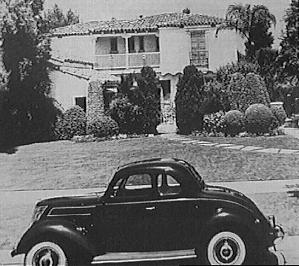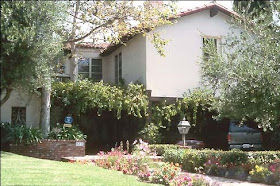Harlow was born in turn-of-the century Kansas City, Missouri. Jean's first residence was the second floor of a modest, gray stone house, located on 3344 Olive Street (torn down in the late 1930s). Her father's dentist office took up the ground floor.
When Jean was four, the family moved to 4409 Gillham Road, which had a park nearby. Her father's offices were located in the "Waldheim Building in downtown Kansas City, where he maintained his practice for the next thirty-six years" (Golden, 16). It was here that Jean began "collecting" pets, including ducks, lambs, pigs, and the usual dogs and cats. She spent her summers at her maternal grandparents 25-room country retreat, Red Gables, which overlooked the Kaw River and was located near Bonner Springs.
This is what came up on Google maps. I have no idea if it is the same house, but it's the right color!
In 1921, Jean's parents divorced. Jean and her mother moved to Los Angeles, where her mother once again tried to fulfill her lifelong dream of becoming an actress. During their stay there they lived first in a rented room in a Sunset Blvd. mansion and later at 1302 North La Brea Ave., which was right down the road from the American Academy of Dramatic Arts. Her mother then remarried and since her dreams of becoming a actress were not coming true, they moved back to Missouri.
In 1927, a teenage Jean eloped with wealthy orphan Chuck McGrew. After a honeymoon cruise with his grandparents, the newly-weds headed back to California. They rented a Beverly Hills bungalow at 618 North Linden Drive, just two doors away from 'It' girl, Clara Bow ( No. 512). Barely giving them time to settle in, Jean's mother and her husband followed, moving in with the young couple.
It didn't take long for Jean to get noticed by Hollywood, and she was soon in the movies that her mother had longed for. This, along with the arrival of Mama Jean, was too much for Chuck, and the two divorced not long after.
Jean and her mother then rented a bungalow at 300 North Maple Drive, Beverly Hills. It was during this time that Jean met MGM exec. Paul Bern.
Jean lived briefly in an apartment at 152 Peck Dr. in 1931.
After Jean began to make it big in the movies, her and Mama Jean moved again, this time at 1353 Club View Drive in West Los Angeles. Mysterious occurrences have happened here.
After Bern and Harlow married in 1932 (in the living room of her Westwood home), they lived in Bern's Bavarian-style house, located at 9820 Easton Drive in Benedict Canyon, Los Angeles. Two months later, Bern committed suicide, causing a huge scandal, as Harlow was suspected of murder. The house is also supposedly haunted. More on that along with lots of photos of the house here.
With all the money Harlow was making, Mama Jean began building herself a mansion at 214 South Beverly Glen Blvd. in Holmby Hills. The house was two stories and had four bedrooms. It had a Gregorian façade, French interior, and outdoor pool with two dressing rooms. She spent $25,000 furnishing it with such things as a walk-in fridge, polar bear rug, a portrait of herself, ermine covered toilet seats, and for her Baby, an ermine covered headboard for her bed.
Powell's pool
Harlow's last residence was 512 North Palm Drive, located between Sunset Blvd. and Wilshire. She leased it for $300 a month. The house was 4,400 sq. feet and has 5 bedrooms and 5 baths. Two doors down, at No. 508, is the 1950s residence of Marilyn Monroe, where she lived with Joe DiMaggio.
The house as it looked in 1937, the year Jean Harlow died. Source.
Sources:
Golden, Eve. Platinum Girl: The Life and Legends of Jean Harlow. 1991.
Stenn, David. Bombshell: The Life and Death of Jean Harlow. 1993.
Artunian, Judy & Mike Oldham. Movie Star Homes: The Famous to the Forgotten. 2004.
Online Sources:
The Platinum Blog - "Today" photos of Club View home
Paradise Leased - An Afternoon in Harlow Heaven - lots of 'then' and 'now' photos
Haunted Houses - Harlow's Westwood Home
House Crazy - Benedict Canyon home
And...scene! - William Powell's Beverly Hills Home
Dear Mr. Gable - final home
LA Bartender - The Original Platinum Blonde - final home
Seeing Stars - final home
Classic Movie Favorites - Jean Harlow's Homes (of course I didn't come across this one till I was nearly done with my post)































































